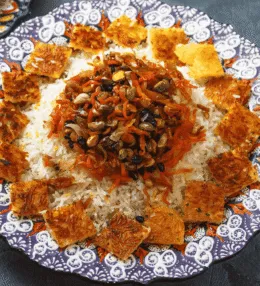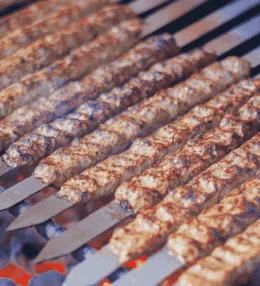
- View
Table of Contents
ToggleBissara, made from fava beans and subtly seasoned, this hearty soup has been a staple of Moroccan households for generations. Whether you’re enjoying it as a simple breakfast on a chilly morning or as a filling dinner after a long day, Bissara brings warmth, nourishment, and a taste of tradition in every spoonful.
Want to dive deeper into Moroccan Cuisine? Don’t miss our post on 18 Traditional Moroccan Foods to Try
What Is Bissara?
Bissara, often known as Moroccan fava bean soup, is a velvety puree made from dried fava beans, sometimes with the addition of split peas for extra depth. It’s simple, yet deeply satisfying, with a texture that’s thick and creamy.
The dish is typically garnished with a generous drizzle of olive oil, a sprinkle of cumin, and a dash of paprika, adding layers of flavour that enhance its earthy, rustic character. It’s often served with crusty bread, making it perfect for dipping and savouring every bit of its rich flavour.
Bissara is popular across Morocco, particularly in the colder months when its warmth is most appreciated. Despite its simplicity, it embodies the essence of Moroccan cooking, making the most out of humble ingredients to create something deeply flavourful and comforting.
Ingredients and Taste
The primary ingredient in Bissara is dried fava beans, which are soaked and then cooked until they become tender enough to blend into a smooth puree.
Some versions also include split peas, which add a slightly sweeter note to the dish. Garlic is often added during cooking, imparting a mild pungency that complements the beans’ natural earthiness.
Once blended, the soup is seasoned with salt, cumin, and occasionally a touch of lemon juice for brightness. The garnish is key to the experience: a drizzle of high-quality olive oil adds richness, while cumin and paprika provide warmth and a hint of spice.
The result is a soup that’s thick, creamy, and deeply satisfying, with a balance of earthy, smoky, and slightly tangy flavours. The olive oil adds a luscious texture that contrasts beautifully with the heartiness of the beans, and the spices elevate the dish without overwhelming its simplicity.
A Taste of History
Bissara has a long history in Morocco, especially in rural areas where it has been a staple for centuries. The dish’s origins are humble, born out of the necessity to create filling and nutritious meals from what was readily available.
Fava beans, being both affordable and highly nutritious, were an ideal choice for families looking to create a dish that could sustain them through the day.
Traditionally, Bissara was often enjoyed by labourers and farmers, providing the energy needed for a long day of work. Over time, it became a beloved comfort food across Morocco, cherished not only for its nutritional value but also for its rich, satisfying flavour.
Today, Bissara is enjoyed by people from all walks of life, whether served at home or found in small eateries where it’s ladled into bowls and topped with a swirl of olive oil and fragrant spices.

Moroccan Bissara (Fava Bean Soup) Recipe
Ingredients
- 500 g dried split fava beans or split peas
- 3 cloves garlic peeled
- 1 tsp ground cumin
- 1 tsp paprika
- ½ tsp cayenne pepper optional, for a bit of heat
- 2 tbsp olive oil plus extra for drizzling
- Juice of 1 lemon
- Salt and pepper to taste
- 1 litre water or vegetable broth
- Fresh parsley or cilantro finely chopped (for garnish)
Instructions
- Rinse the dried fava beans thoroughly under cold water to remove any dust or impurities. Place the beans in a large bowl and cover with cold water. Let them soak overnight or for at least 8 hours to soften
- Drain and rinse the soaked fava beans. In a large pot, combine the beans, garlic cloves, and 1 litre of water or vegetable broth. Bring the mixture to a boil over medium to high heat.
- Once the mixture reaches a boil, reduce the heat to low and let it simmer for about 45 minutes to 1 hour, or until the fava beans are completely tender. Stir occasionally and skim off any foam that forms on the surface.
- Once the beans are tender, use an immersion blender to puree the mixture until smooth. Alternatively, you can transfer the mixture to a countertop blender in batches and blend until smooth, then return it to the pot.
- Add the ground cumin, paprika, cayenne pepper (if using), and olive oil to the pot. Stir well to combine all the flavours. Let the soup simmer for another 10 minutes to allow the spices to infuse fully.
- Season the soup with salt and pepper to taste. Adjust the seasoning if needed, adding a little more cumin or paprika for a more intense flavour if desired.
- Stir in the freshly squeezed lemon juice just before serving to add a bright, tangy note that balances the richness of the beans.
- Serve the Bissara hot, drizzled with extra olive oil and garnished with freshly chopped parsley or cilantro. Traditionally, Bissara is enjoyed with crusty bread or warm flatbread for dipping.
Nutrition
You May Also Like






